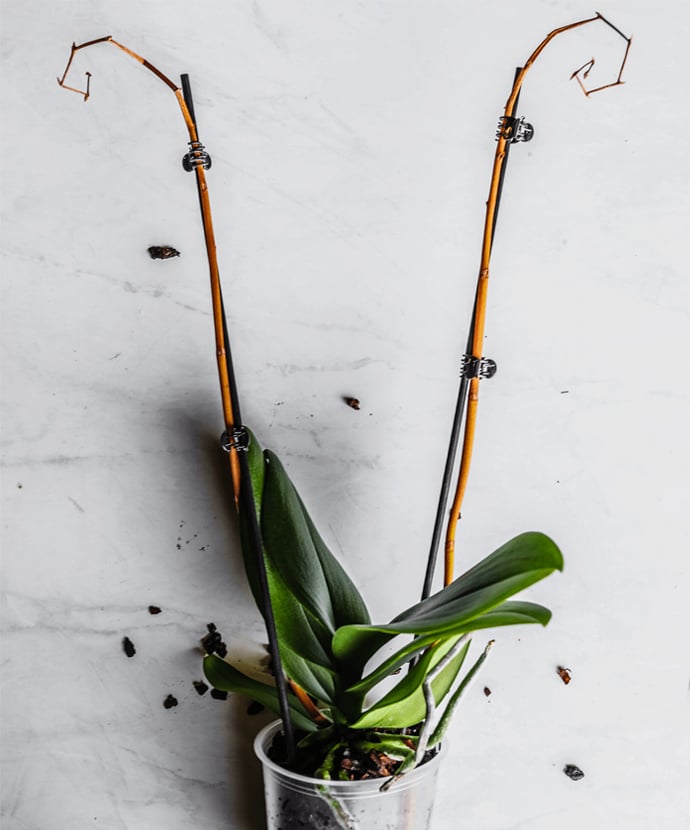
We often hear from our customers that they’re concerned about their orchid ‘dying’ because their stunning orchid has lost all its blooms. Fortunately for you, your orchid plant is not dead, it’s just entering its resting period!
Now that you’re relieved to learn your orchid is still alive and well, your next question is probably going to be, how long do orchids rest? And why? Beauty takes time and effort!
Your orchid’s leaves may gradually lose their bright green gloss and upright stance, turning dull and flattening out around the orchid’s base. It is at this point that many Phalaenopsis orchid owners think their plant has died and regretfully throw it away.
Orchids need to get their beauty rest between blooming periods. During this time, which lasts about six to nine months, they replenish nutrients lost during that awe-inspiring, colorful blooming period.
During the vegetative or 'resting' stage of an orchid's life cycle, its blooms fall off and only the bare stalks remain, leading many owners to believe their plants are done.
But much like Sleeping Beauty, your orchid is probably not dead. Here's how to know for sure.
We know we told you above that your plant isn’t dead and just entering its resting phase, but how can you know for sure? During the vegetative stage, also called by some the dormant or resting phase, many of our customers throw out their perfectly healthy orchids. If you're reading this post, don't do that! Your orchid is still healthy, alive and ready to be cared for to encourage it to rebloom.
1) Crown and roots: If the crown--the part of the plant that connects the leaves and the roots--is brown and mushy (often a result of overwatering), the orchid is likely dead. However, a healthy, resting orchid has roots that are green or green-white and are plump or firm to the touch.
Tip: To avoid overwatering, continue to water your resting full-size, premium orchid the same as you normally would, with three ice cubes once a week. We know it may be tempting to change your watering habits now that the plant looks different, but we promise your plant still needs the same routine despite having no blooms.
2) Yellow leaves: If only the bottom leaf is turning yellow, no need to worry. This is a natural process for the plant to discard the mature leaf to produce a new leaf.
Tip: Make sure your orchid is getting the right amount of light. Place your plant in a north or east-facing window. If you have brighter spots in your home, you can keep your orchid there if you have something like a sheer curtain to diffuse some light.
3) Wrinkled leaves could be a sign of low humidity. Phalaenopsis orchids are tropical and thrive when the humidity is between 55 and 75%.
In addition to low humidity, this condition can also be caused by unhealthy root systems, root rot (usually a symptom of overwatering), dehydration, arid air, and temperature damage.
Tip: In colder climates, combat dry, indoor-forced heat with a humidifier to maintain optimum humidity levels. Depending on the light, you can also keep your plant in the bathroom for extra humidity.
You may be tempted to move your orchid to a dark corner or stop watering it, but that will kill it for sure! Orchids in the vegetative state need proper water and sun, just like an orchid in full bloom. Continue to water it weekly, and ensure it gets plenty of indirect sunlight.
You may want to scale back because the plant isn’t as beautiful as it was in full bloom, but you must continue your care to bring it back to where it is ready to rebloom! When your orchid is resting, this is also a great time to repot (if needed) and fertilize, your orchid will appreciate the extra care while it’s working to rebloom.
Well, we don't have a crystal ball, but there are some things you can do that could speed that process along. Continue to care for your orchid and follow these tips to encourage reblooming.
And if you do end up killing your orchid, we know a great place where you can get another one!
Follow these tips to learn how some simple adjustments can help trigger orchid reblooming.

Copyright Just Add Ice® Orchids 2023